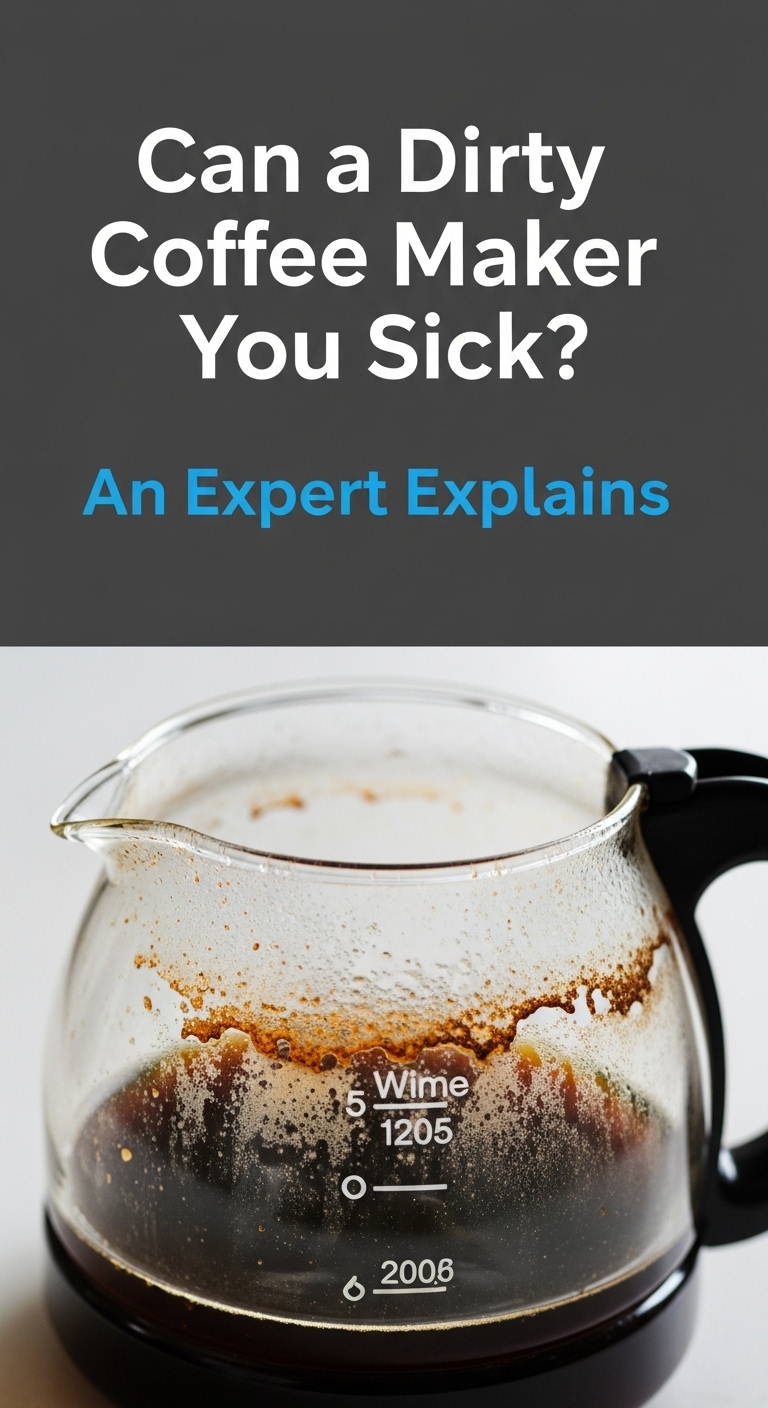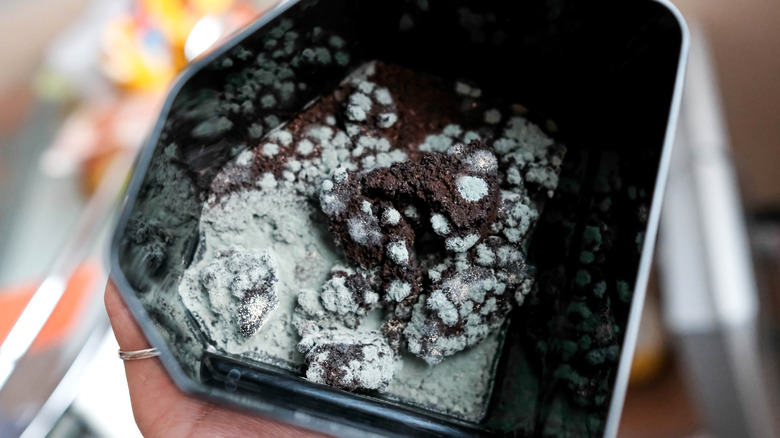As an Amazon Associate CoffeeXplore.com earns from qualifying purchases.
Can a Dirty Coffee Maker Make You Sick? An Expert Explains
Ever wondered what’s really brewing in your machine besides coffee? You diligently pick the best beans and measure the water perfectly, but a hidden, unpleasant truth might be lurking inside your coffee maker. This isn’t just about taste; it’s a genuine health concern that many coffee drinkers overlook.
Yes, a dirty coffee maker can make you sick by creating an ideal breeding ground for harmful bacteria, mold, and yeast. Ingesting these microorganisms can lead to food poisoning, allergic reactions, and other infections.
This guide, leveraging extensive analysis of health data and expert cleaning recommendations, will unpack exactly what’s growing in your machine and why it’s a risk. We’ll explore the specific symptoms to watch for and provide a simple, step-by-step plan to ensure every cup you brew is both delicious and safe.
Key Facts
- It’s a Microbial Haven: A dirty coffee maker’s warm, moist, and dark environment is a perfect incubator for germs. Studies from NSF International famously found that coffee reservoirs can have higher germ counts, including coliform bacteria, than toilet seats.
- Mold is a Common Resident: Research indicates that up to half of all home coffee makers tested contain yeast and mold in their water reservoirs, which can grow rapidly in these ideal conditions.
- Heat Isn’t a Sterilizer: The heat from a normal brewing cycle is not sufficient to kill all pathogens. To be effective, water must be at a rolling boil for at least one minute, a standard that coffee makers do not meet.
- Real Health Risks Exist: Ingesting contaminants from an unclean machine can cause a range of issues, from gastrointestinal distress mimicking food poisoning to allergic reactions triggered by mold spores.
- Taste Suffers, Too: Beyond health concerns, the buildup of old coffee oils and hard water mineral deposits in a dirty machine will make your coffee taste stale, bitter, or generally “off.”
The Unseen Dangers: Why Your Dirty Coffee Maker Can Make You Sick
The answer to the pressing question, can a dirty coffee maker make you sick, is a definitive yes. Health experts and scientific studies, including those highlighted by sources like AdventHealth and NSF International, confirm this risk. A coffee maker isn’t just an appliance; it’s a miniature ecosystem. When neglected, it becomes a hotspot for microbial growth that can directly impact your health. Every time you brew a cup from a contaminated machine, you risk introducing a cocktail of unwanted microorganisms into your body.

The Science of Sickness: What Really Grows Inside Your Coffee Machine?
So, why is a coffee pot such a perfect home for germs? It comes down to a simple recipe: warmth, moisture, darkness, and nutrients from coffee residue. This combination creates an environment where bacteria, yeast, and mold not only survive but thrive. Your coffee maker’s warm, moist, and dark interior is a perfect environment for bacteria like E. coli and Salmonella, as well as various types of yeast and mold, which can multiply rapidly.
A landmark 2011 study by NSF International delivered a shocking reality check: coffee reservoirs were found to have a significantly higher germ count than both toilet seats and bathroom faucet handles. This isn’t just harmless dust; it’s a party of potentially pathogenic microbes.
Here’s a closer look at what could be hiding in your machine:
| Microorganism Type | Specific Examples (from inputs) | Potential Source/Reason |
|---|---|---|
| Bacteria | E. coli, Salmonella, Pseudomonas, Enterococcus | Thrives in warm, moist areas. Can be introduced from hands or contaminated water sources. |
| Yeast | Various common household strains | Ubiquitous in the air, settles in moist reservoirs and feeds on coffee residue. |
| Mold | Various common household strains (e.g., Penicillium, Aspergillus) | Airborne spores settle in the dark, damp interior and multiply quickly. |
Quick Fact: Did you know that up to half of all coffee makers tested in studies were found to contain yeast and mold in their water reservoirs?
The Problem with Mold and Mycotoxins
While the thought of any germ is unsettling, mold presents a particularly insidious threat due to its byproducts. When you see visible signs of mold in your coffee maker, you’re not just looking at a simple cleanup job; you’re looking at a potential source of toxins.

Pro Tip: If you see fuzzy or slimy residue of any color (green, black, or even red) in your reservoir, it’s a telltale sign of mold. Common visual indicators include:
- Fuzzy growth: Often white, green, blue, or black.
- Slimy film: A pink or reddish biofilm can also indicate mold or bacteria.
- Musty odor: A persistent damp, earthy smell coming from the machine.
The primary concern with this growth is that mold in a coffee maker can produce toxic compounds called mycotoxins, which are ingested when you brew coffee, posing a direct health risk separate from the beans themselves. While raw coffee beans can sometimes contain mycotoxins like ochratoxin A, the roasting and brewing process drastically reduces them. The more immediate danger comes from the fresh mold growing inside the machine’s damp, dark components, releasing its toxins directly into your morning brew.
From Bad Taste to Bad Health: Symptoms and Risks Explained
The effects of drinking coffee from a dirty machine aren’t just theoretical. As Hygiene Sue and other health sources point out, the symptoms are real and can range from mild discomfort to severe illness, especially for certain individuals. Think of it like any other food-surface contamination – the symptoms often mimic classic food poisoning.
Symptoms from a dirty coffee maker range from gastrointestinal issues like nausea and diarrhea (food poisoning) to allergic reactions such as sneezing and wheezing from mold spores. Immunocompromised individuals face a higher risk of serious infections.
Here’s a breakdown of the expert-explained symptoms you could experience:
- Gastrointestinal Issues (Food Poisoning)
- Nausea and vomiting
- Stomach cramps and pain
- Diarrhea
- Allergic Reactions from Mold
- Sneezing and runny nose
- Itchy, watery eyes
- Wheezing or worsening of asthma symptoms
- Skin rashes or hives
- Infections and Other Concerns
- For individuals with compromised immune systems, bacteria like Pseudomonas can lead to more serious infections.
- Chronic exposure can contribute to persistent respiratory issues or other low-grade health problems.
While most healthy individuals might only experience mild symptoms or an “off” taste in their coffee, those with mold allergies or weakened immune systems are at a significantly higher risk of a more severe reaction.
The Simple Solution: A Step-by-Step Guide to Cleaning Your Coffee Maker
The good news is that preventing sickness from your coffee maker is simple and requires just a few minutes of regular maintenance. To prevent illness, a consistent cleaning routine is essential: rinse removable parts daily, wash the reservoir weekly, and perform a deep-cleaning descale with a vinegar solution monthly. This three-tiered approach tackles everything from fresh residue to stubborn mineral buildup.
Daily Care (Less than 2 minutes)
This is the single most effective habit for preventing immediate buildup and ensuring better-tasting coffee. Make it part of your coffee routine – just as you add beans, end by rinsing the pot.
- Discard Grounds: Immediately after brewing, throw away the used coffee grounds.
- Rinse Parts: Rinse the filter basket and the coffee pot (carafe) with hot water.
- Leave Open to Dry: If possible, leave the water reservoir lid open to allow the interior to air dry, reducing moisture.
Weekly Wash
Once a week, give your machine a more thorough cleaning to remove coffee oils that can turn rancid, make coffee taste bitter, and act as a food source for germs. Set a weekly reminder on your phone – ‘Sanitize the Source’ for a safe and tasty brew.
- Disassemble: Take out all removable parts: the carafe, the filter basket, and the water reservoir if it’s detachable.
- Wash Thoroughly: Wash these parts in the sink with hot, soapy water. Use a brush to gently scrub away any oily residue or film.
- Rinse and Dry: Rinse all parts completely to remove soap residue. Air drying is crucial to prevent reintroducing a moist environment where microbes thrive.
Monthly Deep Clean & Descaling
This is the most critical step for eliminating hidden mold and bacteria. The monthly deep clean uses the power of vinegar to descale and disinfect the machine’s internal components. This process removes mineral deposits (scaling) from hard water, which create rough surfaces where bacteria and mold can cling and thrive.
- Create Solution: Fill the water reservoir with a solution of half white vinegar and half water.
- Start Brew Cycle: Place a paper filter in the basket and run the coffee maker through half of a brew cycle.
- Let it Sit: Turn the machine off and let the hot vinegar solution sit in the carafe and inside the machine’s tubing for 30-60 minutes. This allows the acid to break down mineral deposits and kill mold.
- Complete Cycle: Turn the machine back on and complete the brew cycle.
- Rinse Cycles: Discard the vinegar solution and the filter. Now, run at least two to three full cycles with fresh, clean water to flush out any remaining vinegar residue.
Pro Tip: The smell of vinegar will dissipate completely after you run a few cycles of fresh water, leaving you with a cleaner machine and better-tasting coffee.
Debunking Common Coffee Maker Myths
Misconceptions about coffee maker hygiene are common and can lead to a false sense of security. Let’s clear up a few myths to ensure you’re not unknowingly putting your health at risk. Contrary to popular belief, the heat from brewing is not sufficient to kill all bacteria and mold, and single-serve machines like Keurigs also require regular cleaning to prevent microbial growth.
Myth: “The hot water from brewing kills all the germs.”
“My coffee maker gets super hot, so it must be sanitizing itself with every brew.”
It’s a common assumption, but the science tells a different story. Fact: Most coffee makers don’t get hot enough for long enough to kill all germs; boiling water must be sustained for at least one minute for sterilization, which brewers don’t do. The water in a typical drip coffee maker heats to between 195-205°F, but it passes through the system too quickly to have a sterilizing effect on the colonies of bacteria and mold hiding in the reservoir and tubing.
Myth: “Single-serve (Keurig) machines are cleaner and don’t need washing.”
“I just use a pod and it’s all contained, so there’s nothing to clean.”
Have you checked the water reservoir or pod holder on your single-serve machine lately? Fact: Single-serve brewers have internal water reservoirs and tubing that stay moist and dark, making them equally prone to mold and bacteria growth and requiring the same cleaning diligence. The needle that punctures the pod and the pod holder itself can become caked with coffee residue, and the internal water tank is just as susceptible to biofilm and mold as any drip machine. These machines require the same weekly washing and monthly descaling to stay safe.
To make your cleaning routine even more effective, consider using dedicated descaling solutions or cleaning pods designed for your specific machine.
FAQs About a Dirty Coffee Maker & Your Health
What are the first symptoms of mold in a coffee maker?
The first signs are often sensory. You might notice a musty, earthy smell coming from the machine, or your coffee may start to taste “off” or unusually bitter. Visually, you may see a slimy, often pinkish or black film on the surfaces of the water reservoir or find fuzzy green or white spots in the filter basket area.
What are the symptoms of coffee machine food poisoning?
Symptoms of food poisoning from bacteria in a coffee maker are the same as from any other contaminated food source. They typically include nausea, vomiting, stomach cramps, and diarrhea. These symptoms can appear within a few hours to a day after consuming the contaminated coffee.
How quickly can mold grow in a coffee maker?
In the ideal warm, dark, and moist conditions of a coffee maker reservoir, mold can begin to grow in as little as 24 to 48 hours. If the machine is used daily and not allowed to dry out completely, a colony can establish itself very quickly, which is why consistent cleaning is so important.
Does vinegar really kill all the mold in a coffee maker?
Yes, white distilled vinegar is highly effective at killing most common household molds and bacteria. Its acidic nature breaks down the structure of these microorganisms. Running a vinegar solution through your machine for a monthly deep clean is a proven, safe, and effective way to disinfect the internal components.
Can I get sick from a workplace coffee machine?
Absolutely. Workplace coffee machines can pose an even higher risk because they are used by multiple people and are often cleaned less frequently and less thoroughly. High-touch surfaces like the carafe handle and brew buttons can also be sources of germ transmission, making personal and machine hygiene in an office setting crucial.
Will a dirty coffee maker make my coffee taste bad?
Yes, this is one of the most immediate and noticeable effects. Built-up rancid coffee oils will impart a bitter, stale flavor, while mineral deposits from hard water can give the coffee a dull or chalky taste. A clean machine is the first and most important step to brewing a delicious cup.
What happens if you drink coffee from a machine that hasn’t been cleaned?
When you drink coffee from an uncleaned machine, you are likely ingesting a mix of mold spores, yeast, and various bacteria that have been multiplying inside it. This can lead to a range of outcomes, from simply a bad-tasting cup of coffee to allergic reactions, food poisoning symptoms, or even more serious infections if you have a compromised immune system.
Your Healthiest Cup Starts with a Clean Machine
The evidence is clear: the answer to can a dirty coffee maker make you sick is a resounding yes. But this isn’t a reason to give up your beloved coffee ritual. Instead, it’s an empowering call to action. By understanding the risks and embracing a simple, consistent cleaning routine, you take complete control over the health and quality of every cup you brew. A clean machine is the foundation of great coffee.
Don’t let a dirty machine stand between you and a safe, delicious cup of coffee. Take 5 minutes this week to follow the cleaning guide and taste the difference.
Here are the key takeaways to remember:
* The Risk is Real: Your coffee maker is a prime breeding ground for bacteria and mold that can cause food poisoning and allergic reactions.
* Heat is Not Enough: The brewing cycle does not sterilize your machine. Only manual cleaning can do that.
* Cleaning is Simple: A three-part routine of daily rinsing, weekly washing, and monthly descaling with vinegar is all it takes to eliminate the risks.
* All Machines Need Care: This applies to both classic drip machines and single-serve brewers like Keurig.
* Cleanliness Equals Quality: A clean machine not only protects your health but also dramatically improves the taste of your coffee.
Last update on 2025-12-06 / Affiliate links / Images from Amazon Product Advertising API

